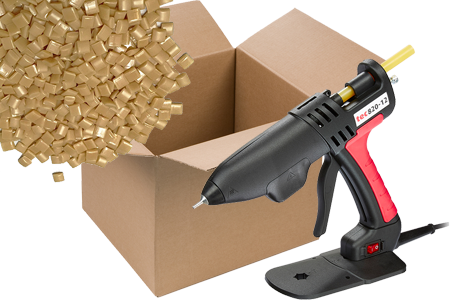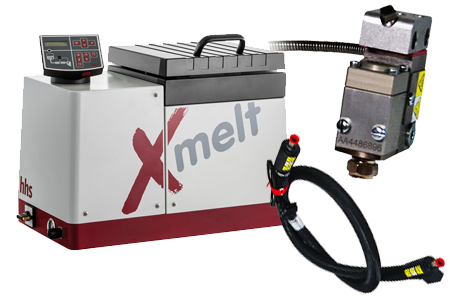May 30, 2024
Some manufacturers will send out thousands of cases or cartons a day. But when these boxes do not stay closed, it can lead to an enormous number of problems. If you’re involved with end-of-line packaging, chances are you’ve dealt with these packaging pop-opens before.
What Are Packaging Pop-Opens?
Packaging pop-opens refer to when box flaps on a case or carton “pop open” after compression because they were not properly sealed. Pop-opens are a fact of life for many manufacturers and are usually related to the hot melt adhesive being applied. While they may be common, they can be costly.
The Cost of Packaging Pop-Opens
For a business, the actual cost of pop-opens in packaging can vary. In the field, the cost of hot melt pop-opens can be massive. Packaging failures during shipment or in the hands of a customer can lead to expensive return shipments, soured relationships, and lasting damage to your company’s reputation.
In production, any amount of downtime means big financial losses for some businesses. For others, occasional pop-opens are just a minor headache. They simply require some extra resources with the team being taken off the line to seal up the packages by hand. But when pop-opens start happening regularly, it is time to act before the business suffers.
Common Hot Melt Pop-Open Causes & Solutions
We get a lot of calls from companies dealing with pop-opens and understand just how costly these problems can be. Although we are happy to help when things go wrong, we’d rather help you avoid these disasters in the first place.
After years of helping manufacturers troubleshoot pop-open issues, we've found that almost all case and carton pop-opens are caused by a handful of basic problems that can be relatively simple and inexpensive to fix. Now we are sharing our knowledge with a list of the most common causes of packaging pop-opens and how to avoid them.
Problem 1: Clogged Equipment
Clogged equipment is the most obvious problem that causes glue pop-opens. If hot melt isn’t being dispensed correctly, cases and cartons certainly aren’t being sealed.
Char is the most obvious culprit when it comes to clogged equipment. Char builds up in the tank and eventually works its way to the hoses and nozzles. For some production lines, this means frequent downtime while filters and nozzles are replaced.
Once char starts to be an issue, it is also very difficult to clean. The best strategy to avoid both clogs and pop-opens is to try to prevent adhesive charring from happening in the first place. A machine like the Graco InvisiPac HM10 can help reduce such buildup because of its melt-on-demand technology.
Problem 2: Hot Melt Coverage
Another common cause of hot melt adhesive pop-opens is how the glue is dispensed. The volume and pattern of the hot melt matters and affects how well it bonds during compression. The wrong volume or wrong pattern can lead to pop-opens after compression.
Most commonly, there is not enough hot melt applied. Some manufacturers will try to save on costs by using less, but they end up costing themselves in the long run. On the other hand, too much hot melt can be equally problematic because it reduces the speed at which the adhesive sets. Either way, it is typically an easy fix. A slight operational change that alters how much adhesive is applied can often do the trick.
If you think coverage might be the source of your pop-open problems but are not sure what the right amount is, check out these tips on estimating hot melt coverage.
Problem 3: Hot Melt Temperature

It’s critical that hot melt is dispensed at the right temperature and that the temperature remains consistent. If the temperature is too high or too low, you can end up with pop-opens in your boxes.
Running hot melt too hot can cause the adhesive to set too slowly. Running it too cold causes it to set too quickly. Similarly, external factors may also cause the temperature to fluctuate and lead to intermittent carton and case pop-opens.
You should check that your hot melt is running at the recommended temperature. Some equipment is also better at managing temperature than others. The Meler B4 Series hot melt tank, for example, has temperature control ranging from 40ºC to 200ºC with an accuracy of ± 0.5ºC. If your machine doesn’t have such accuracy and temperature continues to be a problem, it may be worth upgrading.
Problem 4: Substrate Changes
Changes in packaging materials happen more often than you might think. While you would hope packaging manufacturers would notify production teams about these changes, that’s not always the case.
We have seen this happen to many manufacturers. Somewhere along the way the packaging coatings and fiber content are updated. As a result, there are sudden, unexplained packaging pop-opens on the line as the hot melt is no longer able to fully penetrate the material. It can sometimes take these companies weeks to determine the source of the problem.
Collaboration is the first step to determine if a change was made. If so, the solution may involve changing the materials back, updating the adhesive, or tweaking the production process.
Problem 5: Shipping & Storage Temperature
If your company has never had to deal with hot melt pop-opens in the field, consider yourself lucky. When cases and cartons pop open in the hands of your customers, you can expect some angry complaints and expensive returns.
Most hot melts have relatively narrow service temperatures. When sealed cases and cartons are stored in hot or cold environments, the adhesive bond can be compromised and eventually fail.
Avoid this messy situation by checking the temperature everywhere the case and cartons go and making sure each place falls into the acceptable temperature range.
Fix Pop-Opens Before They Cost You
Stop letting hot melt pop-opens be a regular part of your business. If you are struggling to solve your packaging pop-open issues, we want to help. Contact us today to speak with an adhesive expert. You can also download our detailed guide for more information.












